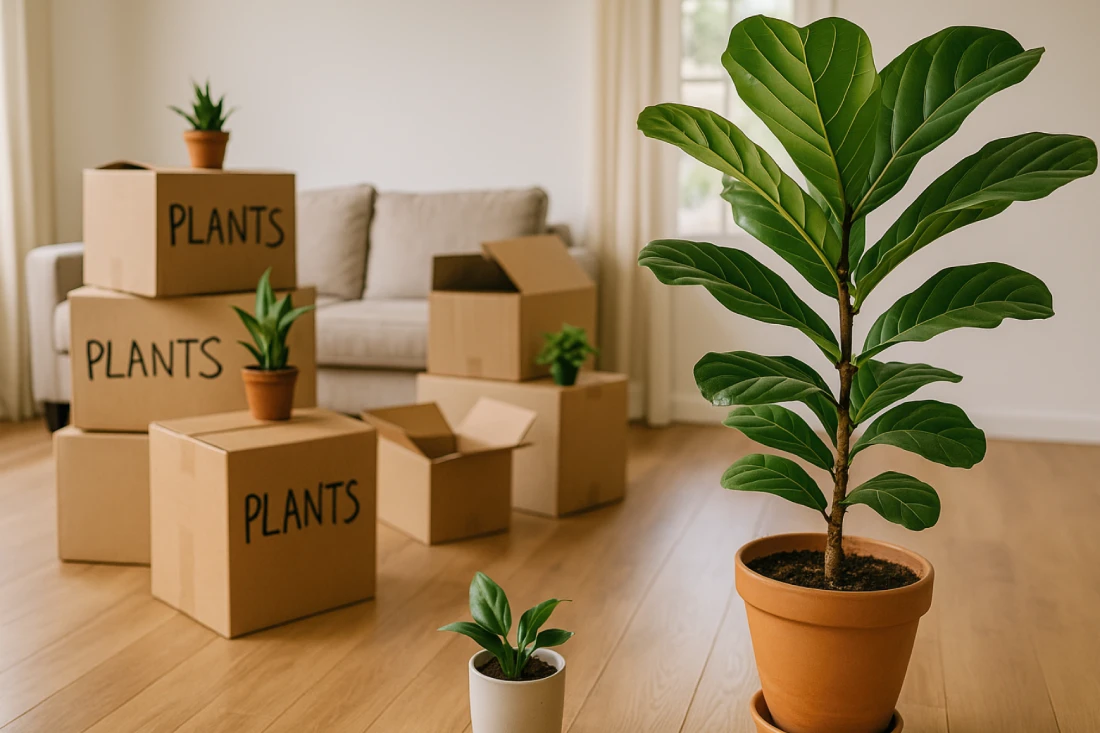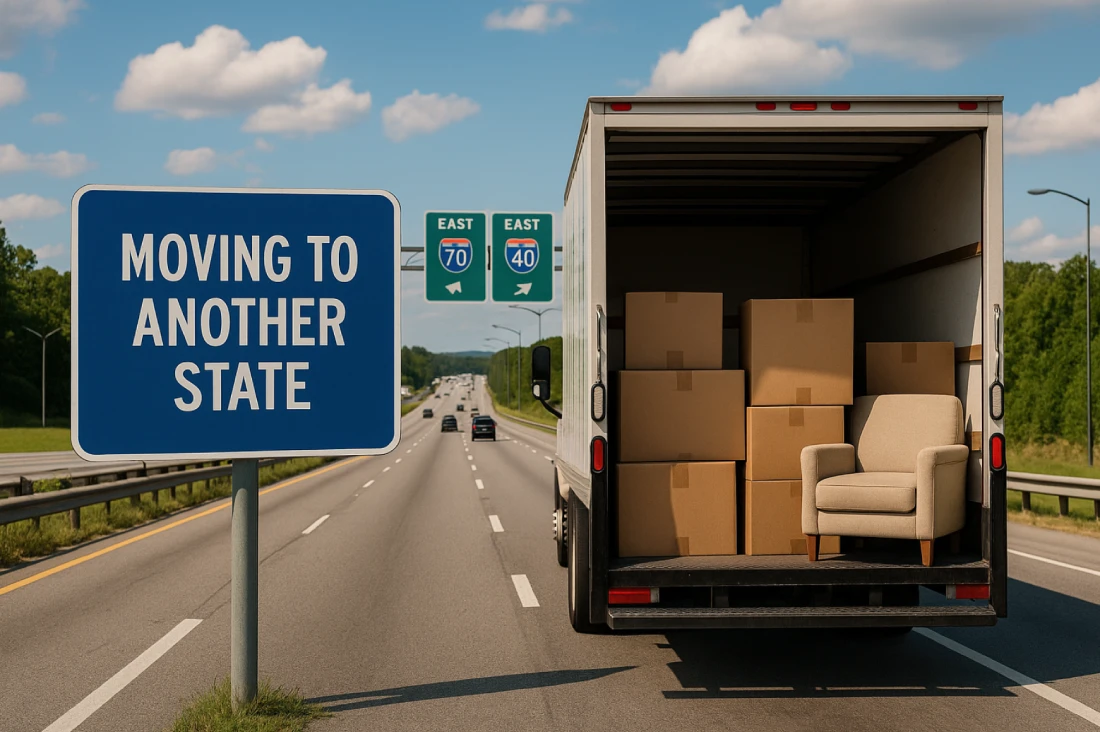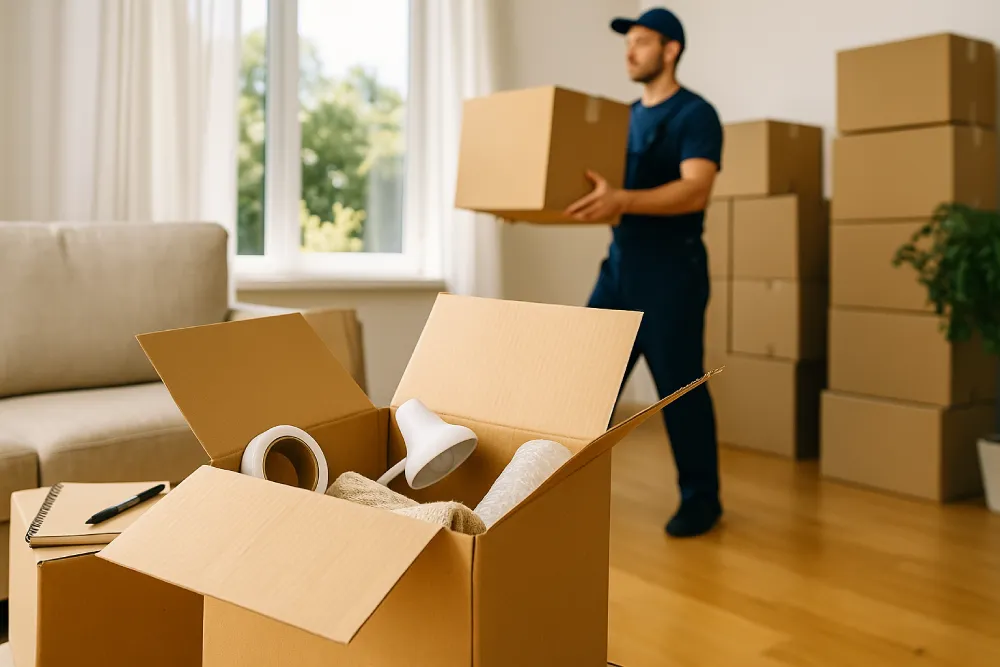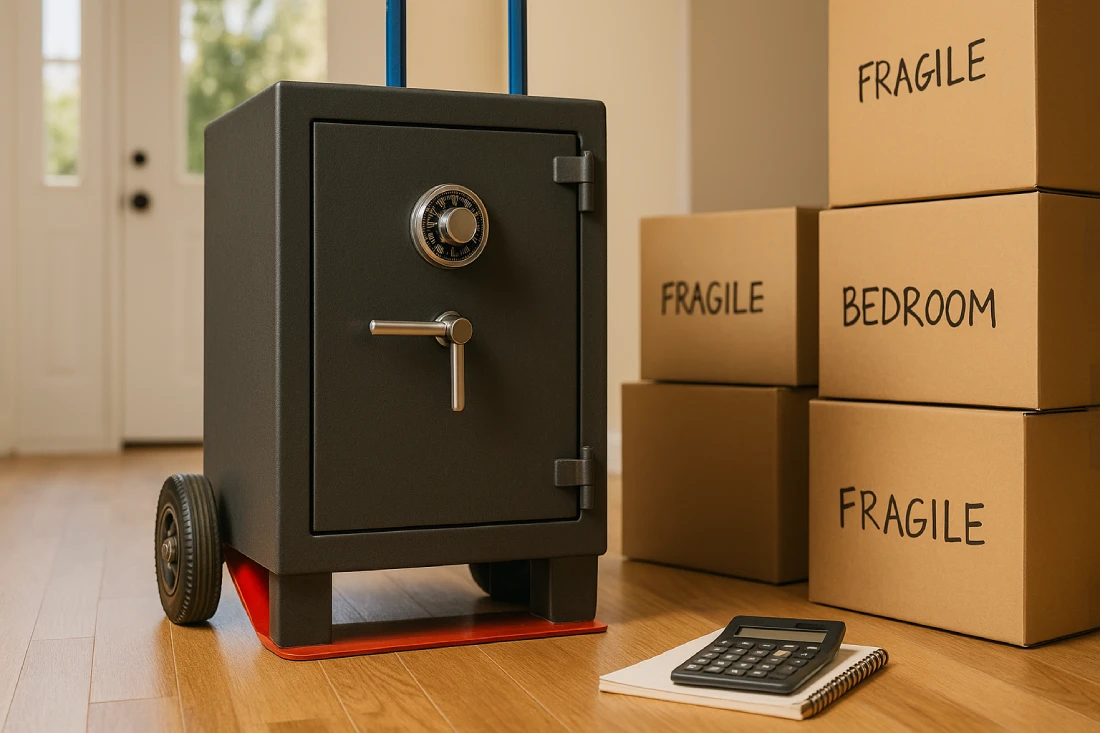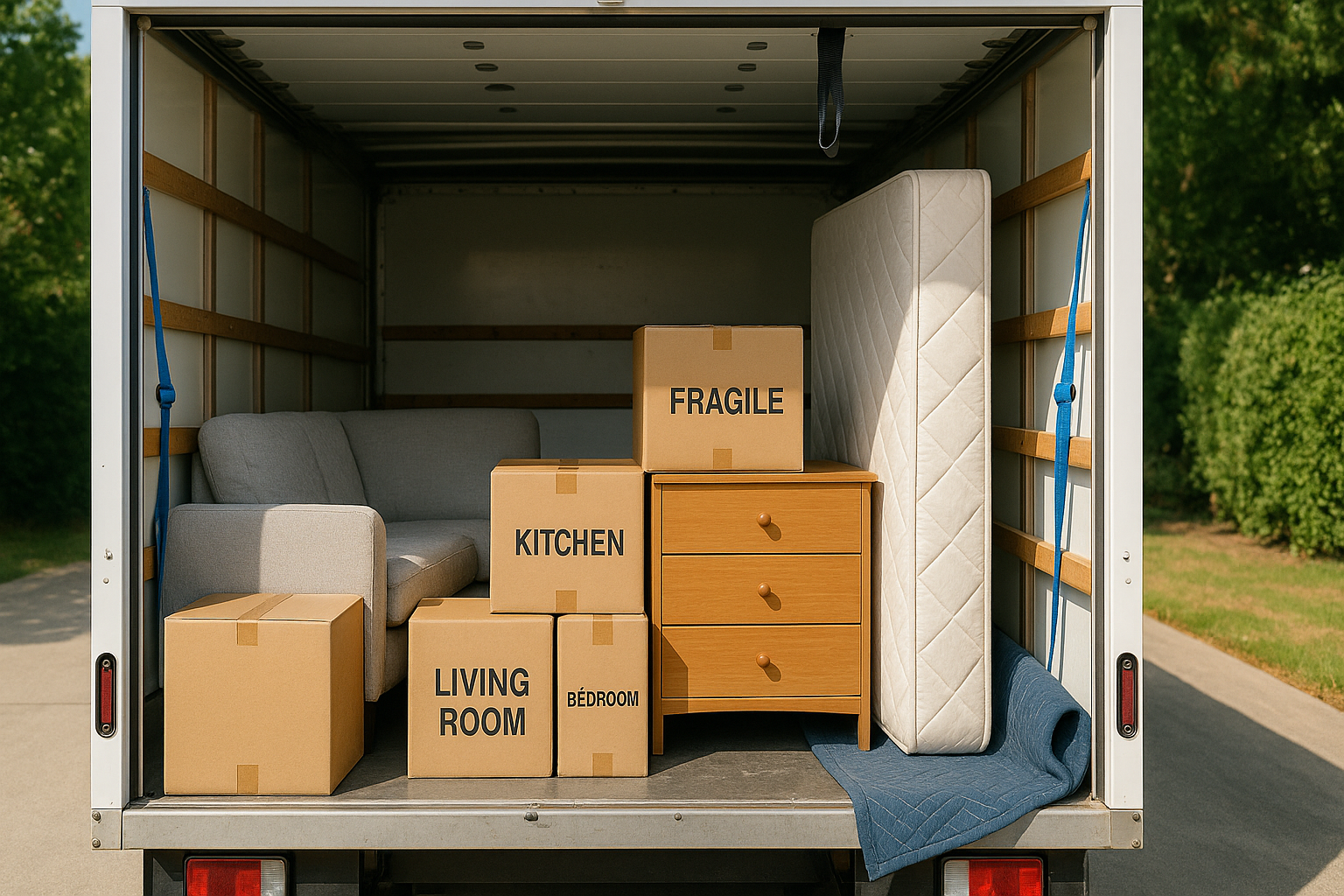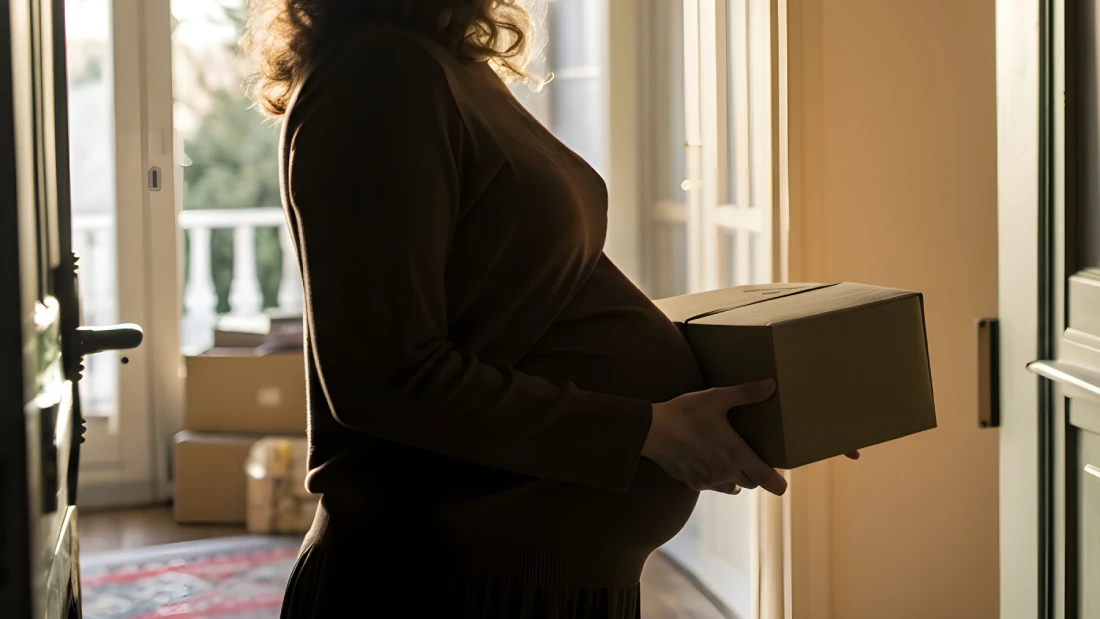Learning how to pack a TV for moving starts with gathering the right materials—original boxes with foam inserts, specialty TV moving boxes, bubble wrap, and corner protectors. You'll need to disconnect cables carefully, remove stands or wall mounts, and wrap the screen in protective layers before boxing. The process requires keeping the TV upright during transport and securing it properly in the moving vehicle.
This article walks you through each step with specific techniques for protecting screens and corners, guidance on choosing between original and aftermarket boxes, and safe loading practices. You'll learn professional methods that work whether you're moving across town or cross-country, helping you avoid the most common mistakes that damage flat-screen TVs during relocation.
Materials You'll Need for Packing Your TV
Before starting the packing process, gather all necessary supplies to protect your TV during the move. The right materials make the difference between a TV that arrives safely and one that gets damaged in transit. Having everything ready also speeds up the packing process when moving day arrives.
Original Box vs. TV Moving Box Options
The original TV box with its custom foam inserts provides the best protection for your specific model. If you kept it, you're already ahead of the game. The manufacturer designed these boxes and foam pieces to fit your TV perfectly, cushioning all the vulnerable points during shipping.
Without the original box, specialty TV moving boxes from U-Haul, Home Depot, or moving supply stores work well. These adjustable boxes come in various sizes to fit different TV dimensions. A U-Haul TV box kit includes foam corner protectors and fits most TVs between 32 and 70 inches. Measure your TV diagonally before buying to get the right size.
Additional Protective Materials
Beyond the box itself, you'll need bubble wrap for the screen, with two layers providing optimal protection. Get enough to cover the entire TV surface without leaving gaps. Moving blankets add extra cushioning and work great for filling empty space in the box.
Packing tape secures everything in place, but never put tape directly on the TV screen or frame. Foam sheets or a screen protector sleeve prevents scratches on the display. Corner protectors shield the most vulnerable parts of your TV from impact. Zip ties or Velcro straps keep cables organized, while labels help you identify boxes and remember cable connections.
Preparing Your TV for Packing
Proper preparation prevents damage and makes setup easier at your new home. Taking a few minutes for these steps saves hours of frustration later. Start this process at least a day before moving to give your TV time to cool down completely.
Documentation and Disconnection
First, power down your TV and unplug it from the wall. Let it sit for at least an hour to cool and discharge any static electricity. While waiting, take photos of all cable connections on the back of the TV. These pictures become invaluable when reconnecting everything at your destination.
Unplug all cables systematically, starting with the power cord. Coil each cable neatly and secure it with a zip tie or Velcro strap. Place all cables and remotes in labeled plastic bags. Tape these bags to the outside of the TV box or pack them in a clearly marked separate box. This organization prevents the frustrating search for missing cables on moving day.
Removing Stands and Wall Mounts
The TV stand or wall mount must come off before packing. These attachments create stress points that can crack the screen during transport. For TV stands, lay the TV face down on a soft blanket or towel on a flat surface. Unscrew the stand carefully, keeping track of all screws and hardware.
Wall-mounted TVs require extra care during removal. Have someone support the TV while you disconnect it from the bracket. Place all mounting hardware and screws in a labeled bag immediately. Tape this bag securely to the TV stand or mounting bracket so everything stays together. Write "TV HARDWARE" clearly on the bag to find it easily later.
Wrapping and Protecting Your TV
The wrapping process determines whether your TV survives the move intact. Each layer serves a specific purpose in protecting different parts of your TV. Take your time with this step, as rushing increases the risk of damage.
Screen Protection Techniques
Start by cleaning the screen with a microfiber cloth to remove dust and fingerprints. Apply a foam sheet or screen protector sleeve directly against the display. This first layer prevents scratches from other packing materials. If you don't have a screen protector, use a soft blanket or sheet as the first layer.
Wrap bubble wrap around the entire TV, starting with the screen side. Use bubble wrap with the bubbles facing outward, away from the screen. This orientation provides better cushioning. Apply two complete layers, overlapping each wrap by half to eliminate gaps. The bubble wrap should extend beyond the TV edges by at least two inches on all sides.
Securing Corners and Edges
Corners take the most impact during moves, making extra protection necessary here. Attach foam corner protectors to all four corners of your wrapped TV. If you don't have foam corners, create your own by folding bubble wrap into thick triangular shapes and taping them in place.
Secure everything with stretch wrap or packing tape, but only attach tape to the bubble wrap or protective materials. Run tape around the TV horizontally and vertically to create a stable package. The wrapping should feel firm but not so tight that it puts pressure on the screen. Add an outer layer of moving blankets for extra protection, especially for long-distance moves.
Boxing Your TV for Moving
The boxing stage provides the rigid protection your TV needs during transport. A properly boxed TV can withstand the bumps and shifts that happen in moving trucks. This step makes the difference between professional-quality packing and amateur attempts.
Using the Right Box Size
Your TV box should be slightly larger than the wrapped TV to allow for cushioning material. A box that's too small puts pressure on the TV, while one that's too large allows dangerous movement. The wrapped TV should have 2-3 inches of space on all sides for padding material.
Place the TV upright in the box, never flat. The screen can't support the TV's weight when horizontal. Slide the TV in carefully, keeping it centered in the box. If using a specialty TV moving box, follow the manufacturer's instructions for inserting foam corners and supports. These boxes often have specific slots and grooves for proper TV placement.
Filling Empty Spaces
Every gap in the box becomes a danger zone where your TV can shift and hit the sides. Fill all voids with soft packing materials like bubble wrap, packing peanuts, or crumpled newspaper. Pay special attention to the spaces around corners and edges. The TV shouldn't move at all when you gently shake the box.
Seal the box thoroughly with quality packing tape. Run tape along all seams and edges, creating an H-pattern on top and bottom for extra strength. Don't skimp on tape, as box failure during moving can destroy your TV instantly. Double-tape the bottom of the box since it bears all the weight.
Proper Labeling and Handling Instructions
Clear labeling prevents mishandling and ensures everyone knows they're dealing with fragile electronics. Good labels also help you find and prioritize unpacking your TV at your new home. Use large, bold writing that's visible from several feet away.
Write "FRAGILE" on all six sides of the box in large letters. Add "THIS SIDE UP" with arrows pointing upward on at least two sides. Include "FLAT SCREEN TV" so handlers understand exactly what's inside. Mark which room the TV goes to at your destination, saving time during unloading.
Add handling instructions like "KEEP UPRIGHT" and "DO NOT STACK" to prevent common moving mistakes. If you're using professional movers or getting help from a moving labor service like Moving Muscle, these labels help them handle your TV correctly. Consider using bright-colored, fragile stickers in addition to written labels for extra visibility.
Loading and Transporting Your TV Safely
How you load and secure your TV in the moving vehicle determines its survival rate. Many TVs that were perfectly packed get damaged during transport due to poor loading decisions. Understanding proper placement and securing techniques protects your investment. Consider hiring movers without a truck for loading and unloading. This allows you to do the packing, but get professional assistance for moving large and cumbersome screens and safely packing it along with your other belongings.
Vehicle Placement Strategies
Always transport your flat-screen TV standing upright, mimicking how it normally sits. The internal components and screen aren't designed to handle weight when lying flat. Position the TV between stable, flat items like a mattress and sofa back, which provide support without sharp edges.
Never stack anything on top of your TV box, no matter how light it seems. Even small items can shift and create pressure points that crack screens. Place the TV against the truck wall if possible, using moving straps to secure it in place. The TV should be one of the last items loaded and the first items unloaded to minimize handling. Learn how to adequately and safely pack a moving truck by yourself.
Temperature Considerations
Extreme temperatures affect TV components and can cause permanent damage. During summer moves, avoid leaving the TV in a hot vehicle for extended periods. In winter, cold temperatures make screens more brittle and prone to cracking. Let your TV reach room temperature gradually before powering it on at your destination.
For long-distance moves, consider climate-controlled transport options if moving through extreme weather zones. If that's not possible, wrap the TV in additional blankets for insulation. Plan rest stops in shaded areas during summer and avoid overnight stays where the TV would sit in freezing temperatures.
Unpacking and Setting Up at Your Destination
The unpacking process requires the same care as packing to avoid last-minute damage. Many people rush this step in their excitement to set up their entertainment system. Taking your time here prevents damage after successfully completing the move.
Unpack the TV in a clear, open space away from foot traffic. Keep it upright while cutting away box tape carefully. Remove packing materials slowly, checking for any damage as you go. Save the box and packing materials until you confirm the TV works properly.
Let the TV sit at room temperature for at least two hours before plugging it in. This adjustment period prevents condensation damage if the TV was exposed to temperature changes. Use your cable connection photos to reconnect everything correctly. Test all inputs and functions before discarding packing materials or filing any damage claims.
Professional Help vs. DIY: Making the Smart Choice
While packing a TV yourself saves money, some situations call for professional assistance. Large TVs over 65 inches become difficult for one person to handle safely. The weight and size make proper wrapping and boxing challenging without help. Consider your physical capabilities honestly before attempting to move a large TV alone.
Stairs, narrow hallways, and tight corners increase the risk of damage during DIY moves. Professional movers have equipment and experience navigating these obstacles safely. If you're hiring help for loading and unloading through a service like Moving Muscle, they can handle the heavy lifting while you maintain control over the packing process.
For particularly valuable or delicate TVs, professional packing services provide extra peace of mind. They carry insurance for damages and know specialized techniques for different TV types. Compare the costs of professional packing and moving against the TV's replacement value to make an informed decision.
Common Mistakes to Avoid
Using newspaper directly on TV screens leaves ink residue that's difficult to remove. The paper also provides minimal protection compared to proper packing materials. Many people make this mistake to save money, but cleaning products needed to remove newspaper ink can damage screen coatings.
Laying flat-screen TVs horizontally during transport remains the most common and costly mistake. The screen flexes under its own weight, causing invisible stress fractures that appear later. Even if the TV seems fine initially, these fractures can expand over time, eventually ruining the display.
Rushing the packing process to save time leads to inadequate protection and forgotten steps. Start packing your TV at least a day before moving to avoid time pressure. Trying to pack electronics quickly while managing other moving tasks increases mistakes and damage risk significantly. Discover additional general moving hacks and packing tips to help make your process more seamless.
Final Thoughts on Safe TV Packing
Successfully packing a TV for moving requires the right materials, proper techniques, and patience throughout the process. Following these steps protects your investment and eliminates the stress of potential damage. The time spent on careful packing pays off when you unpack a perfectly intact TV at your new home.
Remember that keeping your TV upright, using adequate cushioning, and clearly labeling the box are the three most important factors in safe transport. Whether you're moving locally or long-distance, these professional packing methods work for any relocation. When you need reliable help with the heavy lifting during your move, professional moving labor services can handle loading and unloading while you stay in control of the packing process and transportation.
Frequently Asked Questions
Can I transport my TV in my car instead of the moving truck?
Yes, transporting your TV in your car often provides better protection than a moving truck. Your car offers climate control and smoother rides with less shifting. Secure the TV upright behind the front seats or in the trunk, padding it with blankets or pillows for extra protection.
How do I know if my packing is secure enough?
Your TV shouldn't move at all when you gently shake the box. The box should feel solid but not bulging from over-packing. When you tap the sides, you should feel cushioning rather than the hard TV surface. If you hear items shifting inside, add more padding material.
What if I notice damage after unpacking?
Document any damage immediately with photos from multiple angles. If using professional movers, notify them before they leave and file a claim according to their policy. For DIY moves with rental truck insurance, contact the insurance provider within their specified timeframe. Keep all packing materials and the damaged TV as evidence until the claim resolves.


